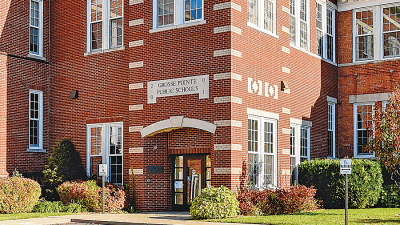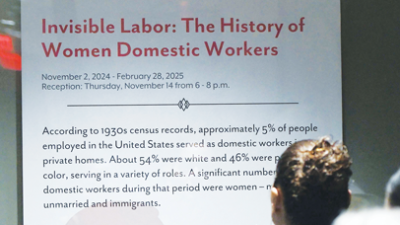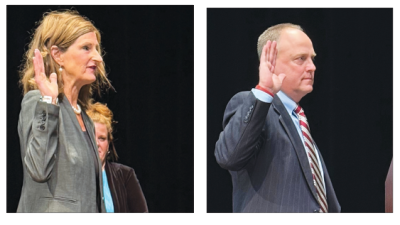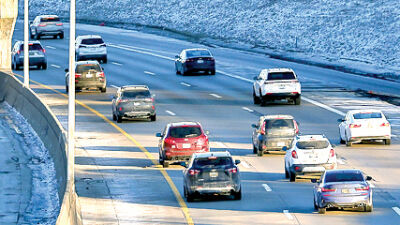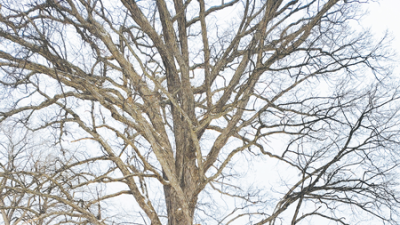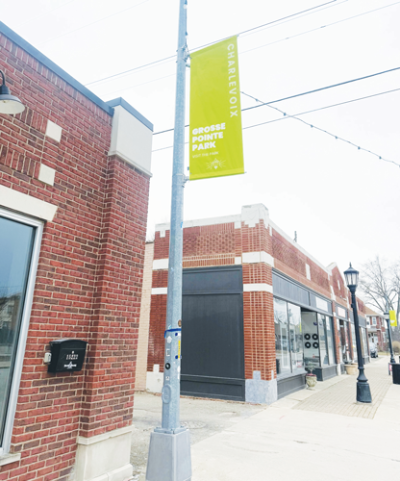
The Charlevoix Avenue business district in Grosse Pointe Park will be getting a number of streetscape improvements next year.
Photo by K. Michelle Moran
GROSSE POINTE PARK — Grosse Pointe Park’s business district on Charlevoix Avenue is expected to get a major makeover in the next couple of years.
The city’s Tax Increment Finance Authorityheld a Charlevoix streetscape kickoff meeting Jan. 8 at Park City Hall to discuss proposed improvements in the coming years. The district runs from Alter Road to Beaconsfield Avenue.
String lights have already been added to the district — they’re similar to the ones in the Park’s Kercheval Avenue business district. But there are other additions officials are also considering, including bike racks, rain gardens, accent brick pavement, artistic fences and planters.
Charlevoix streetscape Project Manager Alex Blehm, who works for OHM Advisors, the Park’s engineering firm, said the city was awarded a $1.8 million Transportation Alternatives Plan grant toward the project. Blehm said this is a federal grant that’s administered through the state.
OHM is recommending wider sidewalks, shorter crosswalks, sidewalk dining, decorative lighting, and the addition of trees and greenery. Another recommendation is making the district a curbless street, which Blehm explained would involve raising the road to the height of the curb. Areas with curbless streets include Bagley Street in Detroit, State Street in Ann Arbor and Main Street in Brighton. Blehm said these streets provide improved accessibility for those who use wheelchairs and people pushing strollers, as well as allowing greater flexibility for festivals and pop-up store events.
Not everyone is convinced a curbless street is the way to go, however. Gallery Animato owner Bob Athey was worried about safety.
“This is a place where people drink a lot,” Athey said, noting the presence of multiple bars.
Athey said vehicles currently “hit the curbs all the time.” Besides pedestrians, he feared what might happen to businesses if an intoxicated motorist came barreling toward one of the buildings.
“I don’t want a car coming through my business,” Athey said.
Blehm said curbless streets are safer and “slow down cars.”
Wider sidewalks would mean a narrower roadway for motorists, which Blehm said would slow traffic. He said that they’re looking at putting up more stops signs, too.
The goals for the project include creating a street that’s inviting and safe, incorporating community spaces to encourage gathering and interaction, making changes that will bolster district businesses, and turning Charlevoix into a destination, Blehm said. Maintaining its distinct Grosse Pointe Park character is imperative as well, he said.
The project is likely to result in the loss of at least some on-street parking spaces, as Blehm said some of the spaces near intersections would be eliminated because they create blind spots for drivers and are therefore safety hazards.
Andrew Curcuru, owner of Ripe Records Detroit, voiced concern about parking.
“I’m a business owner and we have a parking problem,” Curcuru said. “Parking is a problem right now on Friday and Saturday nights.”
That’s due to the many bars and restaurants in the district. Several residents who live near the district confirmed that business patrons end up parking on adjacent residential streets when limited lot and on-street parking gets filled.
Kelly McPhee, a resident of the 1300 block of Beaconsfield, called it a “good plan,” but she did voice some concerns about parking, drainage, rats and whether the businesses would be able to remain open during the construction period.
“My biggest concern is the parking,” McPhee said. “If we have someone visiting, there’s no place (for them to park). We love Charlevoix. We go down there all the time. How it affects us is parking.”
Blehm said excess stormwater would continue to collect in the street. He said there would be a slight slope going down from the business entrances toward the street to direct water there, and said this project “wouldn’t have any effect” on drainage in the neighborhood. Blehm said the possible addition of rain gardens where water tends to pond now would further slow stormwater from flowing into the sewers.
While nothing has been set in stone yet as far as plans for the district, Assistant City Manager and TIFA Director Warren Rothe acknowledged there’s a “strong likelihood” of the district becoming a curbless street. However, he said the plan would still need to be approved by the state and the Michigan Department of Transportation.
As to the increased cost to raise the road, Rothe said that would be negligible because the city was already planning to tear up Charlevoix for the purpose of installing a water main and making sewer improvements underneath the road, which would have necessitated road reconstruction anyway.
“If we’re going to rip the road up, we want to make sure everything else is done, too,” Rothe said.
But as to rats displaced by construction, there’s not much officials said they could do.
Bidding for contractors is expected to take place in early 2026, with construction to start that summer. Rothe said the work is likely to take several months to finish but won’t involve the complete closure of Charlevoix.
“One side of the road is always going to be open,” Rothe said.
Residents, business owners and others will have additional opportunities to weigh in on what they’d like to see in the district. Although dates and times hadn’t been set at press time, future public meetings to discuss the project were slated for March and June, Park officials said.
“We want more of your input,” Blehm said.
The full price tag for the project won’t be known until all details are hammered out and bids are received. Besides the TAP grant, TIFA funds are likely to be applied toward the work.
As outlined in a 2023 document prepared by the Michigan House of Representatives, TIFAs are “entities that ‘capture’ increases in property tax revenue in designated tax increment finance (TIF) districts. Because the increase in property values in a TIF district is expected to be attributable to the TIFA’s development of that area, any tax revenue increases beyond what the property originally yielded go to the TIFA. The base value therefore does not experience any growth over the course of the capture period.”
 Publication select ▼
Publication select ▼
